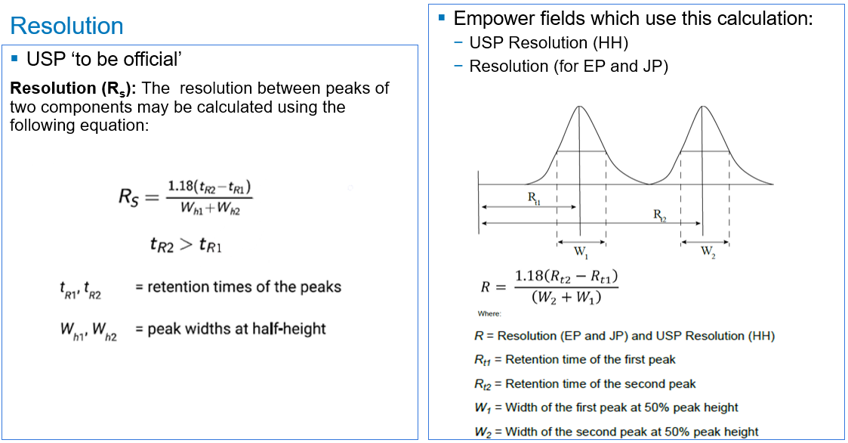USP Chapter 621 for Chromatography - Tip301
OBJECTIVE or GOAL
Review upcoming changes (effective 1 December 2022) to USP Chapter 621 on Chromatography.
ENVIRONMENT
- Empower
- Tip of the Week #301
PROCEDURE
Changes to USP Chapter 621 on Chromatography go into effect on 1 December 2022. Specifically, in this tip, we look at the changes to the calculations that affect Empower. Those calculations are resolution, relative resolution, plate count, tailing factor, and signal-to-noise ratio.
These changes are being made to harmonize the calculations with the European Pharmacopoeia (EP) and the Japanese Pharmacopoeia (JP). Most notably, the USP will use peak widths at half height for resolution, relative resolution, and plate count (i.e., it will no longer use peak widths at tangent).
STEP 1
Resolution is currently calculated using peak widths at tangent. The new calculation uses peak widths at half height. Empower currently reports USP Resolution (HH), EP Resolution, and JP Resolution, all of which use peak widths at half height (Figure 1).

STEP 2
Likewise, relative resolution will be calculated using peak widths at half height. Empower currently reports relative resolution using peak widths at half height for USP, EP, and JP. Selecting All or ChP, Empower will calculate relative resolution using peak widths at tangent (Figure 2).

STEP 3
Plate Count will be called Plate Number. Currently, Plate Count is calculated using peak widths at tangent. The change to the calculation uses peak widths at half height. Empower currently reports EP Plate Count and JP Plate Count, both of which use peak width at half height (Figure 3).

STEP 4
Tailing Factor will be called Symmetry Factor. There is no change to the calculation, and Empower currently reports USP Tailing (Figure 4).

STEP 5
The calculation for signal-to-noise ratio remains the same. The half-height multiplier changes from 5 to 20 for both USP and EP (Figure 5).

ADDITIONAL INFORMATION
This can be done with either the Pro or QuickStart interface.

